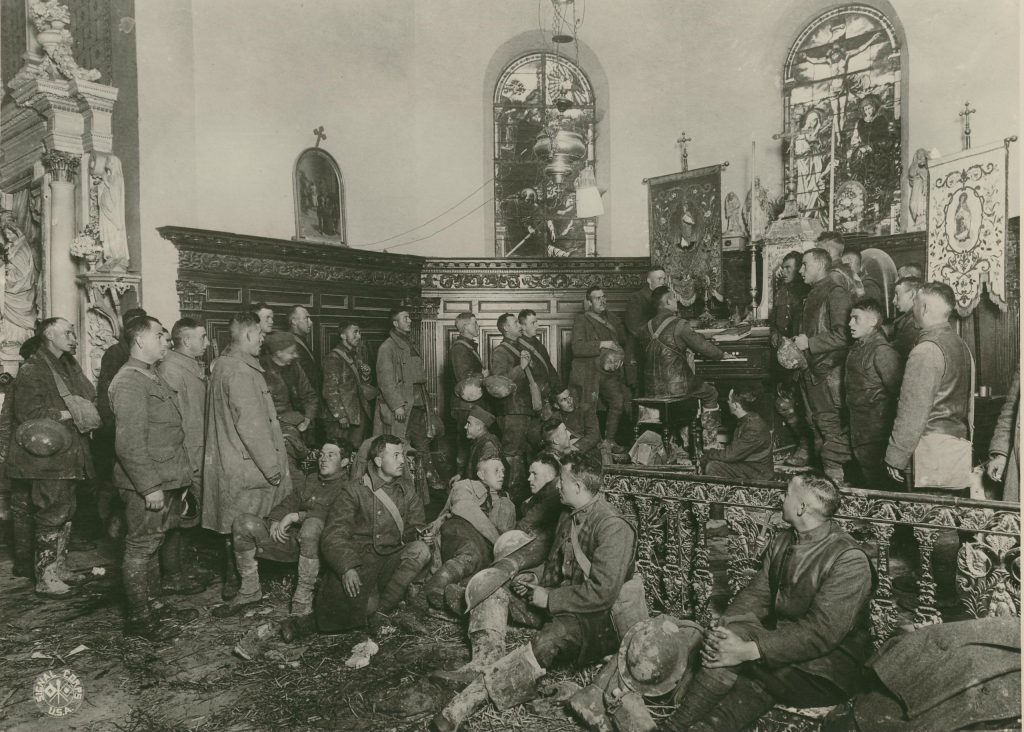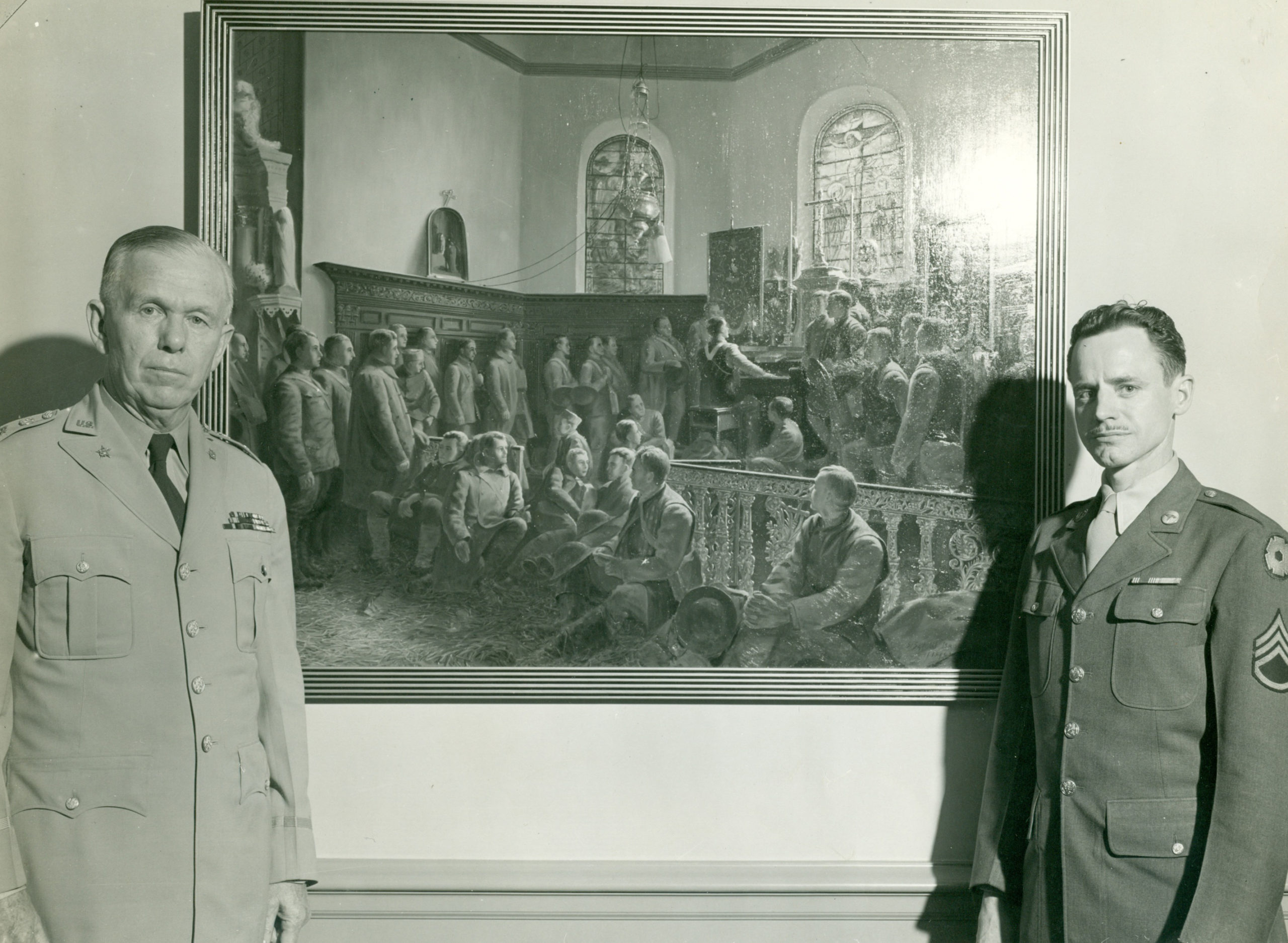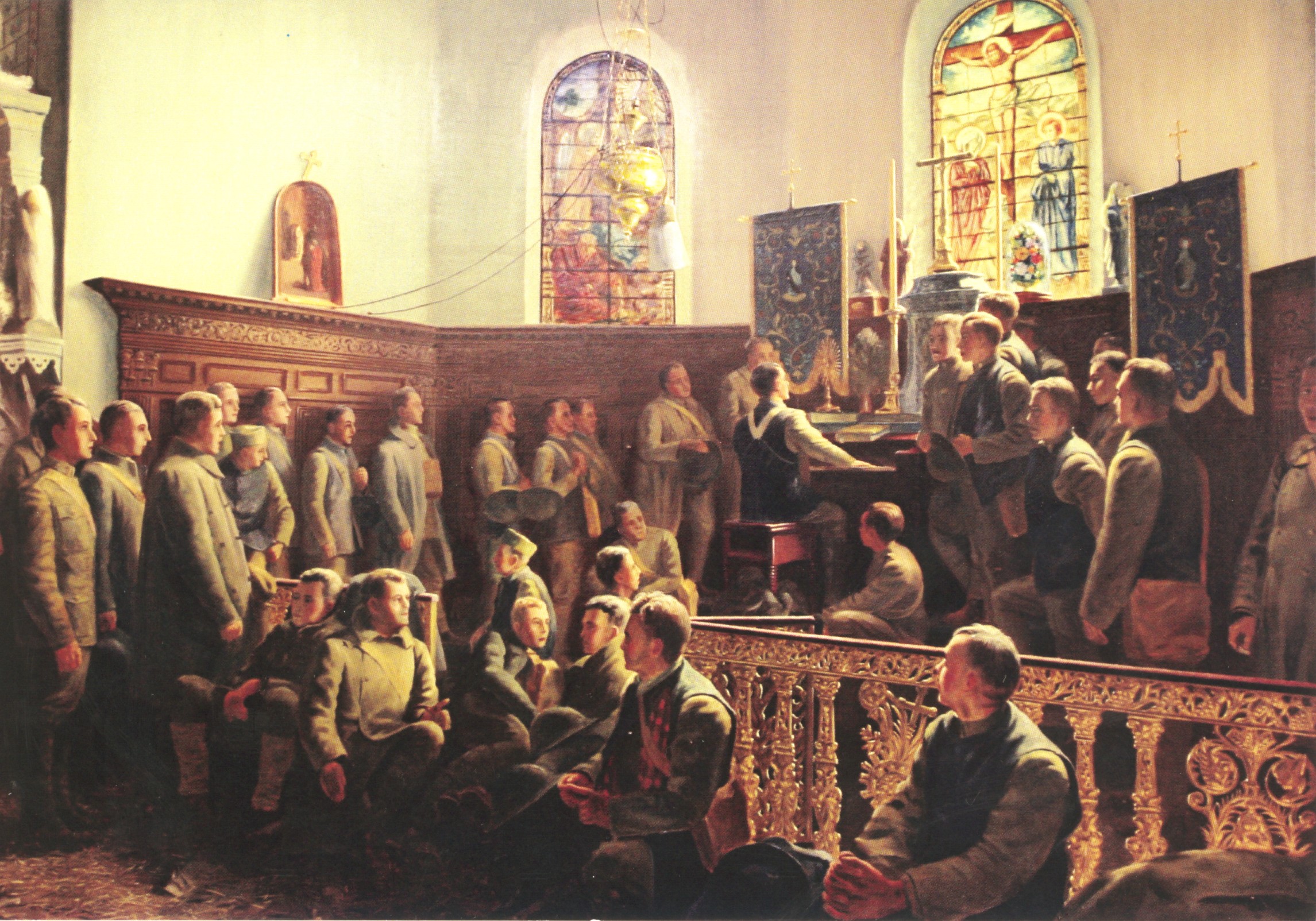This week, the Marshall Foundation says goodbye to our amazing curator, Cathy DeSilvey. We thank her for her years of tireless advocacy for Marshall’s legacy, gift for exhibition planning, and passion for helping objects tell their stories. We have decided to rerun one of her best and most popular pieces as thanks for her years of dedication and friendship. She will be sorely missed, but we know she will flourish wherever good fortune takes her.
One of the most iconic “doughboy” photos to come out of World War I depicts a group of American soldiers resting in a church in the French village of Vaux. It was November 5, 1918, a week before the Armistice, and the men were heading toward Sedan. In the image, Howard Brock plays the organ and leads the men in singing Brighten the Corner Where You Are, a traditional church hymn.

Men of the 80th Blue Ridge Division sing in a church, Vaux, France, November 5, 1918.
The weary men were members of the 317th and 319th Ambulance companies and the 305th Sanitary Train. All were part of the 80th “Blue Ridge” Division, a group composed of men from Virginia, West Virginia, Pennsylvania, and Maryland based at Fort Lee, Virginia. General John J. Pershing, who was commander of the American Expeditionary Forces, described the image: “Of the many thousands of pictures taken of American Soldiers in France in widely varying poses and characteristics, this picture exemplifies the spirit of the American Soldier and is hereby officially designated as ‘The Spirit of the A. E. F.’” The image was also Chief of Staff George C. Marshall’s favorite image. Tired of images of American soldiers shown “drinking and carousing,” he commissioned an oil painting of the reverent photograph to hang in his office at the Pentagon, and after his death, it became part of the Marshall Collection at the George C. Marshall Foundation.
The untitled oil painting was named Church at Vaux by the Foundation staff. The painting had been at the Foundation for several years before any information was gleaned about its creation and history. It was simply signed “S/Sgt. W. Brodeur, 4/13/45,” but the provenance was unknown. Luckily, one of the artist’s sons called the Foundation to track down the painting, and Librarian Barbara Vandegrift was able to write to his father for information. Artist and Staff Sergeant Wallace Edmond Brodeur (1904-2013) was born in Waubaushene, Ontario and arrived in America in 1926. After becoming naturalized, he attended the School of the Art Institute of Chicago, which led to a career as an illustrator for advertisers. After being drafted in 1941, Brodeur was stationed with the Fifth Infantry Division at Fort Custer in Battle Creek, Michigan. He taught art to wounded soldiers at a convalescent hospital and co-founded the “Army Illustrators of Fort Custer,” whose members were referred to as ‘soldier-artists,’ because they illustrated the realities of military life. Reputation and word of mouth led to a very important and unexpected commission. In a 1978 letter to Vandegrift, Brodeur explained the entire history of the painting:
I was approached by two M.P.’s and told that Brigadier General J.E. Bastion of the Percy Jones Convalescent Hospital wanted to see me, immediately. General Bastion informed me that I was to make a large oil painting for the Chief of Staff’s office in the Pentagon. My first reaction was that someone had made a gross mistake. I was a watercolorist, not an oil painter. This was beyond my capabilities. When I left the General’s office, I felt I had convinced him of this…the next day, I received the orders from the Department of the Assistant Secretary of War. I immediately called General Bastion and told him I would comply with the orders to the best of my ability…this painting is the only oil I have ever done. Before being drafted, I was a commercial artist. I illustrated furniture, interiors, cars, merchandise, and even shopping centers from blueprints. All were done in watercolor. I had never done portraits or figures.

General Marshall and artists SSgt Wallace Brodeur, May 21, 1945.
The order for the painting included specific “technical requirements,” including medium (“The depth and richness of the oil medium is most appropriate for the Office of the Chief of Staff”), style, (“Detailed realism is desired”), and lighting (“The flat lighting of the photographer’s flash equipment requires improvement; the location of another source…of illumination being left to the artist’s judgment.”) It took four months for Brodeur to complete the painting, presenting it to Chief of Staff George C. Marshall on or around May 21, 1945.

Church at Vaux painting by Wallace Brodeur.
Marshall delayed Brodeur’s return to Michigan for a short time so the artist could add touches of the previously requested realism: “I added more straw to the floor, additional mud to the soldiers’ shoes, removed the shine from helmets, and generally added more soil to the picture.” Brodeur, his wife Evelyn, and daughter Pam Smith visited the painting at the Foundation in June of 1982. Church at Vaux and a copy of the original Signal Corps photograph are permanently on view at the George C. Marshall Museum.
